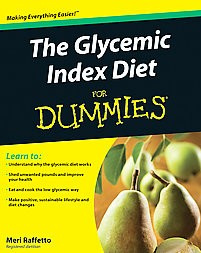YourCheat Sheet To The Glycemic Index Diet
BoostEnergy And Lose Weight With The Glycemic Index Diet
By:Anna Gracey
Tableof Contents
Publishers Notes
Disclaimer
This publicationis intended to provide helpful and informative material. It is not intended todiagnose, treat, cure, or prevent any health problem or condition, nor isintended to replace the advice of a physician. No action should be taken solelyon the contents of this book. Always consult your physician or qualifiedhealth-care professional on any matters regarding your health and beforeadopting any suggestions in this book or drawing inferences from it.
The author andpublisher specifically disclaim all responsibility for any liability, loss orrisk, personal or otherwise, which is incurred as a consequence, directly orindirectly, from the use or application of any contents of this book.
Any and allproduct names referenced within this book are the trademarks of theirrespective owners. None of these owners have sponsored, authorized, endorsed,or approved this book.
Always read allinformation provided by the manufacturers product labels before using theirproducts. The author and publisher are not responsible for claims made by manufacturers.
2013
Manufactured inthe United States of America
Dedication
This book isdedicated to those who seek a healthier lifestyle.
Chapter 1- What Is the Glycemic Index Diet?
When a person's blood sugar levelrises, it releases insulin to regulate it. If the blood sugar level getshigher, more insulin is released. Excessive insulin causes the body to storeextra fat. Different types of carbohydrates have different effects on bloodsugar and consuming primarily those which cause it to stay under control will contributeto a healthier body.

The Glycemic index is a way ofmeasuring the body's blood sugar levels with regard to carbohydrateconsumption. Foods that contain carbohydrates are assigned a number on a scaleof 1 to 100. For most individuals, foods with a low Glycemic index are thepreferred choice in regulating blood sugar levels.
Foods with a high Glycemic value aredigested easily, but they leave you feeling hungry and lethargic within a shorttime. Examples include white rice, white bread, and pasta. These are the typeof foods that nutritionists usually refer to as bad carbohydrates.
Food that has a low Glycemic indexvalue fills you up, but raises blood sugar slowly and steadily. As a result,you feel full longer. These foods are called good carbohydrates, and theyinclude many vegetables, whole grains, and fruits.
The Glycemic index diet is essentialfor people who need to control their blood sugar level. This tool isparticularly useful in treating individuals with diabetes and in weightreduction programs. Food with a low Glycemic rating is perfect for someone thatwants to lose weight because it gives a longer feeling of being full; you areless likely to overeat since you stay satisfied longer. For those withdiabetes, the traditional way of regulating blood sugar levels was throughcounting carbohydrates. But the Glycemic index diet has been designed fordiabetics so that they can choose those foods with a lower Glycemic rating.
Purpose of Glycemic Index Diet List
A Glycemic index diet list isdesigned to show the Glycemic index of different types of foods. This is basedon studies done by nutritionist and specialists in the field. The index shows acompilation of various foods and how they affect blood sugar levels. The foodson the list that are absorbed fast tend to cause blood sugar level to increaseand have a high Glycemic rating. In contrast, foods that are absorbed slowlyand steadily usually keep sugar stable and have a low Glycemic value. It isbelieved that consuming foods that are low on the index list will help keepprevent or control health conditions like heart disease and diabetes.
The Glycemic index diet list helpsindividuals understand that the body handles various carbohydrate foods indifferent ways. While some carbohydrates are absorbed rapidly, others are usedmore slowly and steadily. The blood sugar increases resulting from highGlycemic foods can cause sugar cravings and crashes. This can have adverseeffect on an individual who needs to bring his blood sugar under control.
Find a Copy of the GI Index
Examine it thoroughly andfamiliarize yourself with the various foods and their Glycemic index values.Acknowledge that the idea behind the concept is to consume the right foods. Youneed some fats and you will certainly eat some carbohydrate foods no matterwhat you do. But you need to be certain you consume the correct ones. Steerclear of "bad" carbohydrates and "bad" fats. These areobviously present in fried foods, candy, processed flour, milk shakes and more.Consume adequate amounts of good carbs and include a few good fats in yourdiet. A good example of foods to consume would be steamed asparagus, bakedchicken, and long-grain rice. You can snack on nuts, fruits and cottage cheese.
Fruits that are low on the Glycemicindex include mangoes, apples, cherries, grapes, grapefruit, plums,strawberries, and peaches. High-GI fruits are pineapple, bananas, watermelon,and dates. All vegetables except starches have low Glycemic rating. Milkproducts are also allowed on the Glycemic index diet. Bran cereals and oatmealhave low Glycemic value, and therefore are allowed. Beans can be consumed onthe diet, as it is nutritious, fiber-rich and low on the GI index. Certaingrains can also be consumed, like bulgur, barley, and brown rice.
How to Use the Glycemic Index Diet
The Glycemic Index Diet helps toachieve natural weight loss. Under the Glycemic index table, food items aregiven a value from 1 to 100 to indicate their rank in the amount ofcarbohydrates. Also, foods are grouped into categories indicating how quicklythey enter the bloodstream. To maintain a healthy blood sugar level, it isrecommended to consume foods that have a low Glycemic index value, preferably,50 or less.
Foods with a high Glycemic value canbe consumed occasionally, but they should be consumed with low Glycemic foodsto lower their impact. It is important to find the proper combination of foodswhile still maintaining a low or moderate Glycemic level. This diet plan is notdifficult to follow, but it requires commitment.
Considerations
The information available on theGlycemic index food table can be useful to many individuals. Obviously, it ishelpful for diabetics who need to control their blood sugar level, and it canalso be beneficial for an individual trying to lose weight. Low Glycemic indexfoods also can be helpful in controlling cholesterol and triglycerides, whilehigh Glycemic index foods can help replenish carbohydrate levels after aworkout. The Glycemic index diet promotes weight loss and good health. Certainfoods are healthier than others on the Glycemic index table. By choosing theright foods, you can achieve optimal health and natural weight loss.
Chapter 2- The Benefits of aGlycemic Index Diet
Consuming a low Glycemic diet comeswith an array of different health benefits. Most of the foods eaten today tendto have high Glycemic indexes. These refined, processed and unnatural foods areloaded with a number of harmful contaminants, such as preservatives andflavorings. All of these harmful pollutants are just one of the reasons why youshould eliminate the foods from your diet and opt for something healthier.
Your Health is affected by High GIFoods
When you consume foods that have ahigh GI, your blood glucose levels will increase suddenly. In a manner ofspeaking, bodies dont adjust well to extremes. Since the blood glucose levelssoar at such an alarming rate, HI (high index) foods are detrimental to yourhealth, especially when you consider the long-term effects they have on thebody.
Next page









